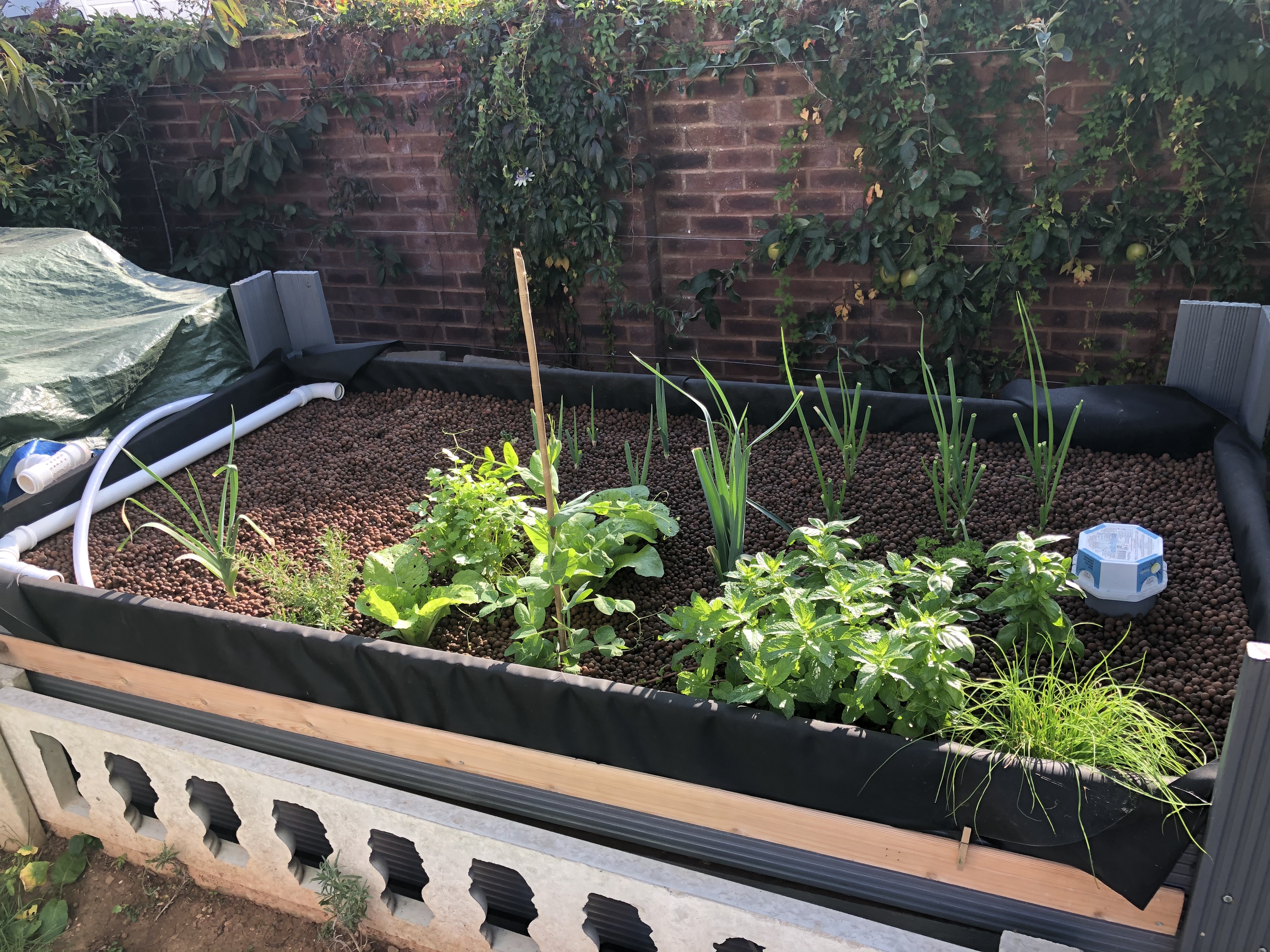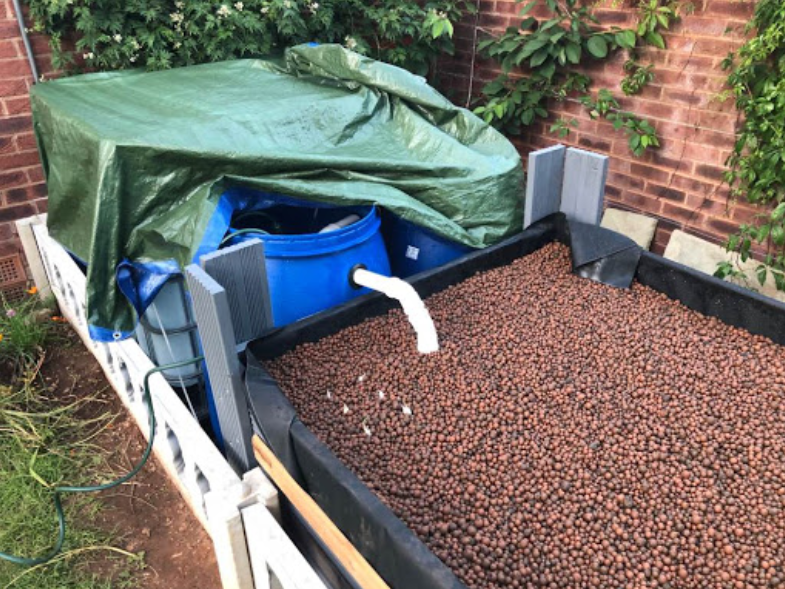Have you sponsored this project? If so, log in to comment on updates!
Growing green!
Filling the system with water.
01/12/2020 UPDATE
Despite challenges like pump failures, regulations surrounding the transport and cultivation of fish and other issues the Aquaponics build has now been finished! As it is up and running, I will be uploading some information here with a few photo highlights and lessons I’ve learned along the way.
Some advice on design. To begin with, the plan was to pump water from a fish pond to a grow bed of expanded clay. A bell siphon of sufficient size would flush when the water in the grow bed was deep enough to flood and drain the grow bed cyclically. This would transport nutrients directly to the roots of plants without drowning them. Throughout the project, changing circumstances and new information have caused that plan to change.
The biggest change to the plan outlined in the pitch was regarding fish feed. Instead of meal worms, commercial fish feed will be used to feed the fish. Regulation surrounding feed used in cultivating fish for human consumption can get complicated and as the project is of a small scale it wouldn’t be able to answer any questions from regulators regarding the quality of meal worm fish feed. Aside from regulations, feeding fish meal worms alone may not provide sufficient diversity of nutrition to ensure healthy fish.
The biggest technical changes were replacing the fish pond with a fish tank, two water treatment vessels and a sump. A timed pump and standing pipe have also replaced the bell siphon. Some advice on design is as follows:
Avoid outdoor ponds. First of all, animals and rodents may visit a pond and foul the water which makes diseases like Leptospirosis a concern. On a related note, a “mushroom” shaped grow bed with legs within and under the grow bed footprint helps prevent animals climbing the sides of the unit. A second concern regarding outdoor ponds is rainfall runoff from surfaces like roads which can introduce contaminants like heavy metals. Finally, cleaning and maintenance in a pond means pulling stuff up from below ground level which can be a pain.
Choose a circular fish tank. With the correct alignment of the inflow from a pump in a circular vessel a current in the fish tank mixes the water, helps keep it aerated and gives the fish something to swim against. While circular tanks are the best choice they can be difficult to find and expensive - a square IBC was sufficient as a compromise between function and cost in this project.
If curved tanks are used, a good alternative to silicone sealant around rigid tank connections to pipes is a uniseal product - a flexible interference fit seal between pipe and tank. One last note on fish tank design, the outflow from the fish tank should regulate the minimum water level by means of a standing pipe or overflow cut out towards the top of the fish tank. Should a pump break or a connection leak it is critical that the fish always have enough water.
Avoid bell siphons. Roots, leaves and other debris will follow the water and block these. Instead, a perforated standing pipe and timed pump should be used. The standing pipe limits the maximum depth in the grow bed while also allowing the grow bed to slowly drain when the pump turns off. A second perforated pipe of larger diameter surrounding this standing pipe works well as a media guard and gives space for maintenance and cleaning.
Consider additional water treatment. Aquaponics systems circulate water from the fish tank to the grow bed and back again. The fish in aquaponics systems produce solid waste and ammonia. The solid waste can cause bad odours and gunk up pipes. The ammonia must be oxidised to form nitrates before the plants can absorb it. Bacteria oxidise ammonia and are most productive in systems with a large surface area and plenty of oxygen. Bacteria will naturally colonise surfaces in aquaponics systems but separate processes dedicated to water treatment ease the load on the grow bed in particular.
A radial flow filter or RFF removes large suspended solids by slowing the flow of water. With less energy suspending solids they separate out through settlement. This helps keep the system clean and is also the first place to check if the fish are being overfed. A moving bed bio reactor or MBBR provides a large surface area in aerated water for bacteria to colonise. Bubbles from the bottom of the vessel stir the media which is usually small plastic parts.
Pick materials and products which work outside. After an aquarium pump failure a pond sump pump has been much more robust in this project. Ideally, pumps in an aquaponics set up should have a float switch and turn off when the level is low as running dry can damage the internal mechanisms in pumps. If parts and tanks are bought second hand it is important to find out what chemicals they’ve been exposed to in the past and whether there are any safety issues regarding bioaccumulation in the fish and veg. This includes where and what items were stored next to as well as what they may have come into contact with directly.
Other considerations for materials outside include using long lasting rubber products like EPDM rubber and protecting metals which will rust. If tanalised wood is chosen for it’s long life in outdoor conditions it should be painted with waterproof paint first. This is because the same chemicals that protect tanalised wood are chemicals that should not leech into the water food is grown with. Painting the wood also helps prevent it warping and changing shape as there is less variation in moisture content. If in doubt regarding plywood, sealants or other materials use marine grade products as these are rated for use in salt water environments. Finally a tarpaulin is useful in protecting parts from sun damage and preventing too much algae growth in transparent tanks.
17/09/2019 Update
We bought some wood!

update
With some admin mix ups it took a little longer than expected but this project now has an official expenses account! It is unfortunate we couldn't start earlier but now the funding is secured we have a new date for the build, 16/09/2019. In the next few weeks we will source the materials for the build and maybe tweak the design. We also need to decide the winter crop!
A big thank you to all the sponsors on this project!
Thank you!
Together, we have reached £510 and with the University's generous donation of £500 there is £1010 plus gift aid to spend on this project. Within a week these funds should be accessible through the University and the project can get started. I hope you are all as excited as I am!

